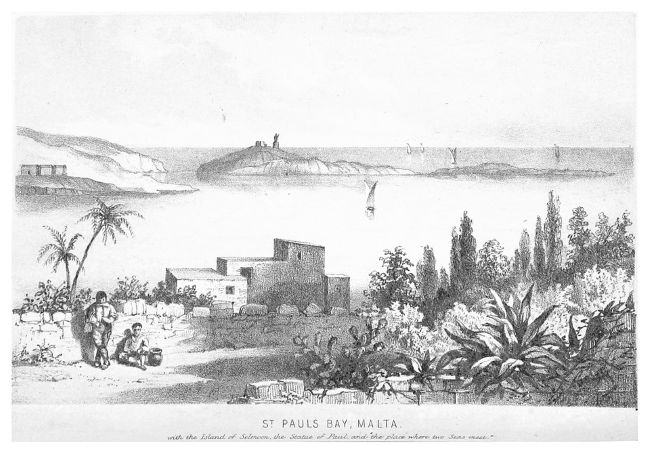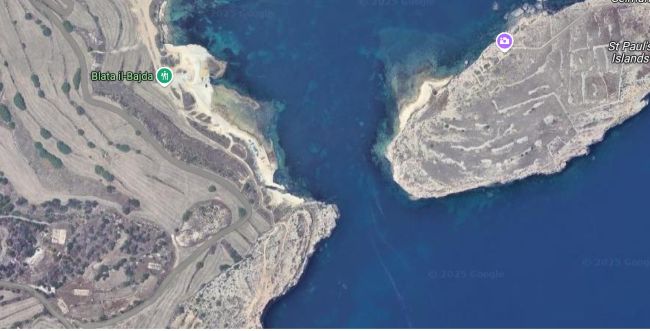| Malta Short Let: Cozy Stay in Gzira | |
|
Sliema Area Modern Designer Finished 2 Bedrooms + Games Room. First floor with Maltese Balcony Large back Terrace with swinging sofa Fully Airconditioned + Full Kitchen 3 TVs, including 65” with backlight. |
 |
|
Book Now: Google Travel | Direct (Cheapest) | Booking.com | Airbnb |
|
St. Paul’s Islands Malta: Where Legend Meets Mediterranean Beauty
Quick Facts:
- Location: 90 meters off Selmun Beach, Mellieħa, Northern Malta
- GPS Coordinates: 35°58’12″N 14°24’00″E
- Size: 0.1 square kilometers (two small limestone islets)
- Height: Larger island rises 20 meters above sea level
- Access: Boat tours (seasonal), swimming, kayaking, or private boats
- Best time: May-October (ideal: April-May, September-October)
- Tour cost: €20-30 for Blue Lagoon tours that may include stop
- Swimming distance: 90 meters (5-10 minute swim for strong swimmers)
- No facilities: Bring water, sun protection, sturdy shoes
- Statue height: 21 meters total (4m statue + 17m platform)
Two tiny islands off Malta’s northern coast hold one of Christianity’s most significant stories, where the Apostle Paul’s legendary shipwreck in 60 AD introduced Christianity to the Maltese archipelago. St. Paul’s Islands (locally called Il-Gżejjer ta’ San Pawl, pronounced “Il-JZay-yer ta San Pawl”) offer visitors a unique blend of biblical history, stunning Mediterranean views, and authentic adventure – all just 90 meters from Malta’s Selmun Beach yet uninhabited since World War II.
Perfect for history enthusiasts, religious pilgrims, nature lovers, and anyone seeking spectacular Mediterranean scenery, these limestone islets covering just 0.1 square kilometers serve as living monuments to Malta’s conversion to Christianity nearly 2,000 years ago. Today’s visitors can walk where legends began, enjoying breathtaking panoramic views while connecting with one of the Mediterranean’s most important religious sites.
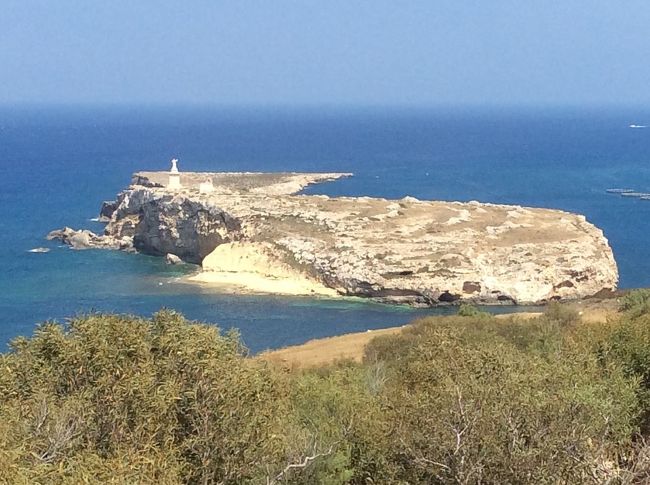
Table of Contents
- When to Visit
- Getting to the Islands
- The Legendary Shipwreck
- What to See and Do
- Essential Preparations
- Natural Wonders
- Religious Significance Today
- Nearby Attractions
- Current Access Information
When to Visit – Perfect Timing for Your Trip
May through October offers the ideal visiting window, with warm weather perfect for boat tours and swimming opportunities. The shoulder seasons of April-May and September-October provide the sweet spot – comfortable temperatures, fewer crowds, and excellent photographic conditions.
Monthly breakdown:
- June-August: Peak season with warmest weather (25-30°C) but largest crowds
- September-October: Ideal conditions with pleasant temperatures and calmer seas
- April-May: Mild weather perfect for hiking, though jellyfish blooms possible
- November-March: Limited tours due to rougher seas and cooler temperatures
The Mediterranean sun is intense year-round, so strong sun protection remains essential regardless of season. Weather-dependent cancellations can occur during winter months when seas become rough.
Getting to St. Paul’s Islands – Access Options and Safety
St. Paul’s Islands are located just 90 meters from Selmun Beach in Mellieħa, offering various access methods for different skill levels and preferences. Important note: No official tour operators specifically service St. Paul’s Islands, though seasonal boat tours may be available from Bugibba – check locally upon arrival.
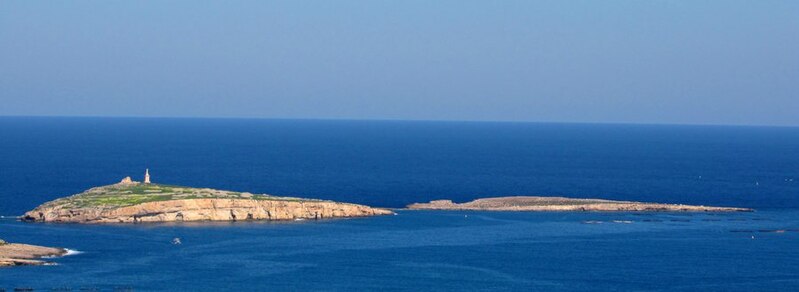
Independent Access Options (Most Common)
1. Swimming from Selmun Beach
- Distance: 90 meters (approximately 5-10 minute swim)
- DANGER NOTICE: Only for strong, experienced swimmers and even then you have Jet ski’s , pleasure boats heavy traffic!
- Check sea conditions before attempting – avoid on windy days
- Never swim alone – use buddy system
- Watch for boats and jellyfish (especially May-June)
- Bring waterproof bag for belongings
- Ask the locals
- Do not over estimate your swimming abilities!
2. Self-Drive Boat Rental
- Bluewaves Watersports in Marfa Bay offers motorboat rentals (www.bluewavesmalta.com)
- Boats include sun canopy, cooler, and safety equipment
- No boat license required for small boats
- Cost varies by boat size and rental duration
- SAFETY: Check weather, wear life jackets, know emergency procedures
3. Kayak or Stand-up Paddleboard
- Rent from water sports centers in Mellieħa or St. Paul’s Bay
- Allow 20-30 minutes paddling time each way
- WARNING: Can be challenging with waves or wind
- Secure belongings in waterproof containers
- Check tide and wind conditions before departing
Seasonal Tour Options
While St. Paul’s Islands aren’t a primary tour destination, some operators include them in broader itineraries:
- Check in Bugibba for seasonal boat trips that may include the islands
- Some Blue Lagoon tours make brief stops (€20-30 typical pricing)
- Private boat charters can be arranged for custom visits
- Most tours focus on swimming/snorkeling rather than island exploration, but you can walk on the island. However I must stress, if you are doing this with kids you need to make sure they do not wonder over the cliffs!
Critical Safety Information
- No lifeguards or rescue services on or near the islands
- Mobile phone coverage can be spotty – don’t rely on it for emergencies
- Rocky landing areas – wear water shoes to prevent cuts
- No shade or shelter – heat exhaustion is a real risk
- Strong currents possible between islands and mainland
- Jellyfish season (May-June) can make swimming dangerous
St. Paul’s Islands remain fully accessible to tourists with no special permits required. The remote nature and lack of facilities mean visitors must be self-sufficient and safety-conscious. Recent visitor experiences (2024-2025) consistently praise the “gorgeous views” and peaceful atmosphere, though access requires more effort than typical tourist sites.
The Legendary Shipwreck That Changed History
According to the biblical Acts of the Apostles, Paul’s grain ship carrying 276 people was caught in a violent storm for fourteen days before running aground on Malta in 60 AD. The dramatic account describes the vessel dropping four anchors before all passengers swam safely to shore, where Paul’s ministry would establish Christianity’s oldest uninterrupted tradition in Europe.
Local legends add rich detail to the biblical narrative. Tradition holds that Paul was bitten by a venomous snake while warming himself by a fire but suffered no harm, leading locals to believe he possessed divine powers. He allegedly healed the Roman governor Publius’s father, resulting in Publius becoming Malta’s first bishop. These stories have become so embedded in Maltese culture that Paul is celebrated as the “Father of Faith” for the Maltese people, with February 10 marking the national holiday of St. Paul’s Shipwreck.
While scholars debate the exact shipwreck location – with competing theories placing it at St. Thomas Bay or Salina Bay – most biblical scholars accept Malta as the location mentioned in Acts 28:1. Archaeological evidence supports early Christian presence through remarkable sites like St. Paul’s Catacombs in Rabat, representing some of the most important Christian archaeological finds outside Rome.
Exploring the Islands – What to See and Do
The islands’ crown jewel is the magnificent 21-meter monument to St. Paul, consisting of a 4-meter statue standing on an 8.3-meter limestone platform. Created by sculptors Sigismondo Dimech (1780-1853) from Valletta and Salvatore Dimech (1805-1887) from Lija, the statue was completed between 1844-1845. St. Paul holds a book in his left hand while his right hand points skyward, with a serpent at his feet representing the biblical account of his snake bite survival.
The marble inscription on the platform reads: “To the Apostle St Paul, Master and Doctor of the Church of all People, Father and Patron of the Maltese. This statue is in the same place where he was shipwrecked – together with 275 others – on this island where he had to come and teach the faith of Christ, as his friend St Luke says in the Acts of the Apostles…”
What to Expect During Your Exploration
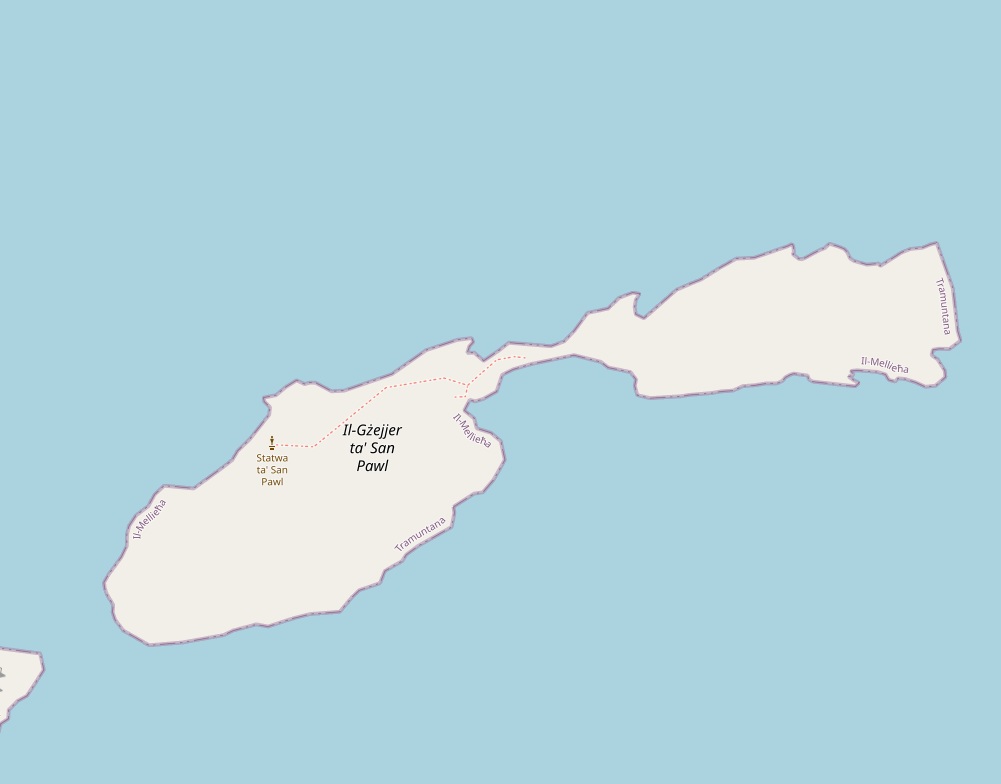
The Journey to the Statue
Your adventure begins at the small stone jetty where boats dock on the larger island’s eastern shore. The well-maintained paved path winds upward through Mediterranean scrubland, offering glimpses of the towering statue ahead. The 200-meter ascent takes 15-20 minutes at a leisurely pace, with several natural resting spots along the way. The path is steep in sections but features carved steps and handholds where needed, making it accessible for most visitors with basic mobility.
Panoramic Viewpoints
From the statue’s base, you’ll enjoy commanding views across four distinct landscapes. To the east, the bustling resort towns of Bugibba and Qawra stretch along St. Paul’s Bay, their hotels and restaurants creating a modern contrast to the ancient islands. Northward, the dramatic cliffs of Mellieħa rise 160 meters above sea level, while the pristine Mellieħa Bay curves below in a perfect crescent of golden sand. Westward views encompass the wild northern coastline toward Għadira Bay, and southward, the endless Mediterranean stretches to the horizon, often revealing distant cargo ships on their way to Grand Harbour.
Historical Discoveries
The watchtower ruins tell a fascinating story of Malta’s defensive history. Built during Grand Master Lascaris’s fortification program in the 1640s, this three-chambered tower once housed soldiers scanning for Ottoman raiders. Two substantial walls still stand, showing the impressive thickness of Knights-era construction. Vincenzo Borg’s ingenious conversion turned the tower into a surprisingly comfortable farmhouse, with evidence of his agricultural terraces still visible on the island’s lower slopes. Stone cisterns carved into the rock demonstrate how residents collected precious rainwater in this waterless environment.
Geological Wonders
The islands showcase millions of years of Mediterranean geological history. The distinctive Upper Coralline Limestone was formed when Malta lay beneath tropical seas, and you can spot fossilized sea creatures embedded in the rock faces. Dramatic weathering has created natural sculptures – wind-carved arches, deep crevices, and platforms where waves have gradually eaten away softer stone layers. The narrow channel between the two islands demonstrates ongoing erosion, with powerful winter storms occasionally washing completely over the lower connecting rocks.
Flora and Fauna Encounters
The hardy Mediterranean vegetation creates a living botanical garden. Golden samphire (kritmu) clings to cliff edges, its succulent leaves glistening with salt spray, while Maltese fleabane produces delicate purple flowers that attract migrating butterflies. Wild thyme carpets rocky areas with aromatic purple blooms, and the rare Maltese salt-tree grows in sheltered spots. Sharp-eyed visitors often spot the distinctive blue-headed lizard basking on warm stones, while wild rabbits dart between low bushes throughout the day.
Photography Paradise
Golden hour transforms the islands into a photographer’s dream. Dawn light (6:30-7:30 AM) bathes the statue in warm amber tones against deep blue Mediterranean skies, while sunset (7:00-8:30 PM in summer) creates dramatic silhouettes with the mainland as backdrop. The contrast between ancient limestone and azure waters provides endless composition possibilities. Storm clouds gathering over Gozo in the distance create particularly dramatic shots, while crystal-clear days reveal the layered blues of shallow and deep Mediterranean waters. Macro photography enthusiasts will find countless subjects in the intricate limestone textures, colorful wildflowers, and fascinating rock pools that form after winter storms.
Essential Visitor Preparations
Since the islands have no modern facilities, proper preparation ensures comfortable exploration. The completely undeveloped environment means no restrooms, shops, restaurants, or shelter exist on the islands themselves.
Essential Items to Bring
- Strong sun protection: SPF 30+ sunscreen (reapply every 2 hours), wide-brimmed hat, quality sunglasses
- Plenty of water: At least 1.5 liters per person – no freshwater sources available on the islands
- Sturdy footwear: Non-slip shoes suitable for rocky limestone terrain, water shoes for swimming
- Camera equipment: Extra batteries/power bank, lens cleaning cloth for salt spray
- Light windbreaker: Islands are fully exposed to Mediterranean winds year-round
- Dry bag or waterproof container: Essential if swimming or kayaking to the islands
Recommended Additions
- Snorkeling gear for swimming away from boat mooring areas
- Binoculars for birdwatching and distant coastal views
- Basic first aid kit: Band-aids, antiseptic wipes, pain relievers
- Reef-safe sunscreen to protect marine ecosystems
- Small towel and change of clothes if planning to swim
- Light snacks – energy bars or fruit for longer visits
Safety Considerations
Environmental hazards to be aware of:
- Jellyfish season (May-June): Purple stinger jellyfish are most common – check conditions before swimming
- Rocky surfaces: Limestone can be sharp and slippery when wet – move carefully
- No shade available: Heat exhaustion risk high in summer months (11 AM – 3 PM most intense)
- Strong currents: Can develop between islands and mainland during rough weather
- Sea urchins: Present on underwater rocks – wear water shoes when entering water
- Unstable cliff edges: Stay back from edges, especially on windy days
Emergency preparedness:
- Save emergency number 112 in your phone before departure
- Inform someone on mainland of your plans and expected return time
- Note that mobile coverage can be weak – don’t rely solely on phone for emergencies
- Consider bringing a whistle for emergency signaling
- Know your swimming limits – the 90m distance can be deceiving with waves or currents
Conservation guidelines:
- Stay on marked paths to protect fragile garigue vegetation
- Do not disturb nesting birds (especially April-August)
- Take all litter back to mainland – leave no trace
- Avoid touching or feeding wildlife
- Do not remove any natural items (stones, shells, plants)
- Respect the Natura 2000 protected status of the area
Natural Wonders and Wildlife Encounters
Despite their small size, St. Paul’s Islands support diverse wildlife populations that enhance the visitor experience. The terrestrial environment hosts wild rabbits, various lizard species, and serves as a crucial stopover for migratory birds during spring and autumn passages.
Marine life around the islands creates excellent opportunities for snorkeling and diving enthusiasts. The surrounding waters contain barracuda, amberjack, tuna, and European parrotfish, while underwater exploration reveals bath sponges, sea squirts, nudibranchs, and octopus. The area’s reefs form part of important Mediterranean ecosystems protected under the Natura 2000 network.
Birdwatching opportunities peak during migration seasons (March-May and September-November) when various species use the islands as resting points along major Mediterranean flyways. Combining visits with nearby Is-Simar Nature Reserve maximizes wildlife viewing opportunities.
Diving sites around St. Paul’s Island Outer and Inner Reefs offer underwater adventures featuring moray eels, conger eels, and diverse marine invertebrates in crystal-clear Mediterranean waters. The dive sites are suitable for various skill levels, with depths ranging from 5-25 meters.
Specific Wildlife You May Encounter
- Blue-headed Maltese wall lizard (Podarcis filfolensis) – Endemic to Malta, most active during morning hours
- Wild rabbits – Descendants of populations introduced centuries ago, best spotted at dawn and dusk
- Mediterranean shag – Coastal birds often seen diving for fish around the islands
- Yellow-legged gulls – Nesting on cliff ledges during spring and summer
- Migratory species – Including bee-eaters, hoopoes, and various warblers during migration periods
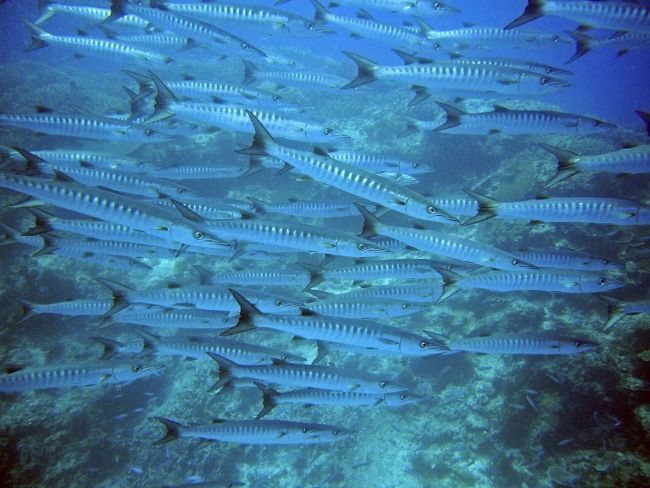
Marine Life for Snorkelers
- Damselfish and wrasses – Common in shallow waters around the rocky shores
- Octopus – Often hiding in crevices, especially active at dawn and dusk
- Sea urchins – Found on rocky surfaces (watch your step when entering water)
- Barracuda schools – Sometimes visible in deeper waters off the island edges
- Colorful nudibranchs – Small sea slugs found on rocks in calmer areas
Religious and Cultural Significance Today
St. Paul’s Islands remain active pilgrimage destinations connecting modern believers with apostolic Christianity. The islands are integral to the Peregrinatio Sancti Pavli Apostoli AD 60 pilgrimage route that includes Malta’s most important Pauline sites.
Contemporary religious observances include annual February 10 celebrations featuring masses, processions, fireworks, and cannon firing from Valletta’s Saluting Battery. Pope John Paul II visited the islands by boat in 1990, emphasizing their continuing religious significance for the global Catholic community.
The Complete Pauline Pilgrimage Route in Malta
The islands serve as starting points for exploring Malta’s extensive network of Pauline sites:
- St. Paul’s Grotto in Rabat: Where Paul allegedly resided for three months, now a chapel with miraculous healing traditions
- St. Paul’s Catacombs: Extensive underground burial complex representing early Christian archaeological evidence
- Church of St. Paul’s Shipwreck in Valletta: Houses alleged relics including pieces of Paul’s wrist bone and the column where he was beheaded in Rome
- St. Paul’s Bay Parish Church: Modern church with impressive murals depicting Paul’s time in Malta
- San Pawl Milqi (St. Paul Welcomed): Archaeological site near Burmarrad believed to be Publius’s villa
- St. Paul’s Church, Safi: Built on site where Paul allegedly shook the viper into the fire
Annual Religious Events
- February 10 – Feast of St. Paul’s Shipwreck: National holiday with special masses, traditional ftira bread blessing, and evening fireworks
- June 29 – Feast of St. Peter and St. Paul: Secondary celebration with boat processions around the islands
- Easter period pilgrimages: Organized boat trips for prayer services at the statue
- International pilgrimage groups: Regular visits throughout the year, especially from Italy and Poland
Nearby Attractions and Itinerary Integration
St. Paul’s Bay area offers excellent tourist facilities while providing access to the islands and complementary attractions:
Within St. Paul’s Bay Area
- Malta National Aquarium: €14.90 adults, €7 children, featuring Mediterranean and tropical marine life
- Wignacourt Tower (1610): Malta’s oldest surviving watchtower, open Mon-Tue and Fri-Sat, €2.50 entry
- Bugibba Square: Evening promenade with restaurants, cafes, and seasonal events
- St. Paul’s Bay Sanctuary: Modern church with impressive Pauline murals
- Kennedy Grove: Coastal gardens with JFK memorial and Mediterranean views
Recommended 6-Day Itinerary from Gzira Base
Stay at our short let in Gzira – a 2-bedroom apartment with full kitchen, air conditioning, and just 1 minute from the Sliema promenade, perfectly positioned for sea lovers.
- Day 1: Valletta harbour tour and explore the capital (15 minutes from Gzira)
- Day 2: Water taxi to the Three Cities for historic exploration
- Day 3: Full day trip to Blue Lagoon, Comino (noting 2025 booking requirements)
- Day 4: St. Paul’s Islands visit – drive to Mellieħa then boat/swim/kayak to islands
- Day 5: Gozo day trip including Azure Window site and Ramla Bay
- Day 6: Golden Bay and western beaches exploration
Transportation from Different Bases
From Gzira/Sliema:
- Drive: 25-30 minutes via Coast Road to Mellieħa/Selmun Beach
- Bus: Route 41/42 to Valletta, then X1 to Mellieħa (total 1.5 hours)
- Cost: €2 day ticket covers all bus journeys
From Valletta:
- Direct bus X1 to Mellieħa: 45-60 minutes
- Taxi: €25-35, approximately 30 minutes
From St. Julian’s:
- Drive: 30 minutes via St. Paul’s Bay
- Bus: Multiple routes available, 1-1.5 hours total
Combined Day Trip Options
- History focus: St. Paul’s Islands morning visit (early start) + Mosta Dome + Ta’ Qali Crafts Village
- Beach day: Early morning island visit + afternoon at Mellieħa Bay or Paradise Bay
- Nature route: Islands + Is-Simar Nature Reserve + Għadira Nature Reserve
- Full Pauline trail: Islands + Rabat (St. Paul’s Grotto and Catacombs) + Valletta church
Conclusion
St. Paul’s Islands Malta offer visitors an extraordinary combination of biblical history, natural beauty, and authentic Mediterranean adventure. These tiny islets serve as living bridges between apostolic Christianity and contemporary faith, where stunning coastal views meet legendary narratives that shaped European Christianity.
Whether seeking spiritual connection, historical exploration, or simply spectacular Mediterranean scenery, St. Paul’s Islands provide unique experiences unavailable elsewhere. The combination of accessible boat tours, manageable hiking, and profound historical significance creates memories that extend far beyond typical tourist attractions.
The islands remind us that sometimes the most significant places come in the smallest packages – two tiny limestone outcrops that changed the course of religious history and continue inspiring visitors nearly 2,000 years later. Your journey to St. Paul’s Islands connects you directly with one of Christianity’s most important founding moments while providing some of Malta’s most spectacular coastal views.
Planning Your Visit – Next Steps
- Check weather forecasts for optimal conditions (winds under 15 knots ideal)
- Book tours in advance during peak season (May-October)
- For swimming: This is not recommended, the gap between the mainland and the islands has heavy boat traffic and there could be currents.
- Prepare essential items the night before
- Consider combining with other St. Paul sites in Malta for a complete pilgrimage experience
- Allow flexibility in your schedule for weather-related changes
- Download offline maps – mobile coverage can be weak on islands
- Start early (before 9 AM) to avoid crowds and heat in summer
- Inform accommodation/someone on mainland of your plans if going independently
Useful Contacts and Resources
- Emergency Services: 112 (works on all networks)
- Malta Tourism Authority: +356 2291 5000
- Weather Updates: www.maltairport.com/weather
- Bus Information: www.publictransport.com.mt
- Jellyfish Alert System: https://maltaweather.com/jellyfish/
- Boat Rental Mellieħa: Bluewaves Watersports +356 9949 2218 (www.bluewavesmalta.com) (no affiliation with this site)

